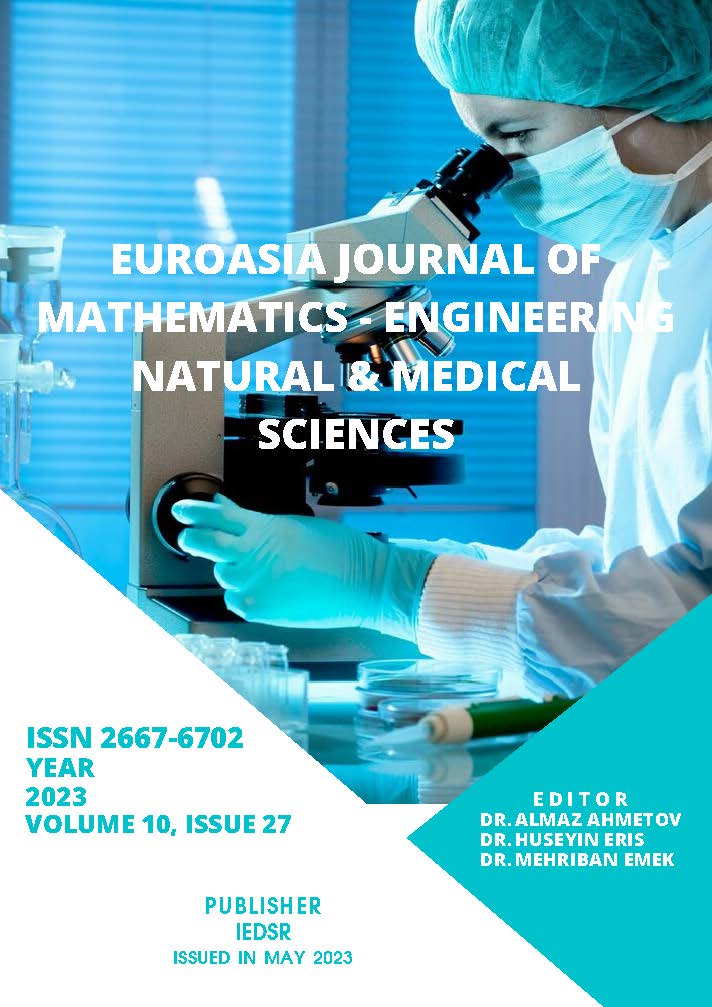Comparative Analysis of 6 Linear Equations Belonging to Langmuir Isotherm Model in Adsorption of Cu (II) Ion with Siirt Akdoğmuş Clay (SAK)
DOI:
https://doi.org/10.5281/zenodo.7969014Keywords:
Adsorption, 6 types of Langmuir, Copper, ClayAbstract
Heavy metals pose a great danger to all living things if they are used more than necessary. Copper is one of the most well-known among these toxic heavy metals, especially for human use, which dates back to ancient times. One of the most effective and economical methods used in heavy metal removal is adsorption. In order to apply this method to isotherm models, efficient isotherm analysis is essential. Adsorption on heavy metals is generally chemical adsorption. For this reason, the most known and used models for the application of chemical adsorption are Freundlich, Langmuir, Temkin and Dubinin-Radushkevich. In fact, although Langmuir's isotherm model is not linear, Langmuir's 6 types of linear equations are derived from this model. It is very important how these 6 types of isotherm equations given together in this study can be used. The clay used in this study is located in Siirt province. It was obtained from Akdoğmuş (gundeseyh) village. SEM, XRD, XRF analyzes of this clay were made. The data obtained as a result of the adsorption process applied to the clay treated with Cu (II) were applied to 6 types of linear equations obtained from the Langmuir isotherm model, and a comparison was made and their suitability was determined by looking at the regression coefficients. According to the results obtained by using the least squares method as the regression model, the degrees of fitness are written in order; type 3= type 6 < type 1= type 4 < type 2 = type 5. shape has been determined. The most suitable R2 values were determined as 0.9997 for type 2 and type 5. The KL values accepted as a measure of affinity are type 2 <type 5 <type 6 < type 4 < type 3= type1. It is understood that qm values are type 5 < type 2 < type 6 < type 4 < type 3 < type 1. The largest qm value was 21,418 and it was determined to belong to type 5.
References
Alacabey, İ. (2014). Doğal ve Aktive Edilmiş Van Gölü Sediment (Dip Çamuru) Örneklerinin Bazı Ağır Metallerle Adsorspsiyonunun İzoterm Ve Termodinamik Analizi. Yüzüncü Yıl Üniversitesi Fen Bilimleri Enstitüsü/Yüksek Lisans tezi. Van: Yüzüncü Yıl Üniversitesi, ss,163.
Bal, N. (2019, Haziran). Kobalt (II) ve Kadmiyum(II) İyonlarının sulu Çözeltiden Klorit İhtiva Eden Killerle Uzaklaştırılması. Yüksek Lisans tezi/Dicle Üniversitesi Fen Bilimleri Enstitüsü. Diyarbakır: Dicle Üniversitesi.
Bazaine, A. A., Turjillo, A. C., & Marquez, M. O. (2022). Adsorption Isotherms: Enlightenment of the Phenomenon of Adsorption. Wastewater Treatment, DOI: 10.5772/intechopen.104260.
Belibağlı, P., & Uysal, Y. (2020). Atık Yumurta Kabuklarından Sentezlenen Hidroksiapatitler ile Sulardan Malahit Yeşil Giderimi. KSÜ Mühendislik Bilimleri Dergisi, 23(3), 141-152.
Buldağ, E. (2018, Aralık). Nikel(II) ve Mangan (II)’nin Sulu Çözeltiden Klorit İhtiva Eden Killerle Uzaklaştırılması. Yüksek Lisanas/Dicle Üniversitesi Fen Bilimleri Enstitüsü . Diyarbakır: Dicle Üniversitesi.
Dal, M. C. (2021, Temmuz). Cu(II), Ni (II) VE Co(II)’nin Karacadağ Skoryası ile Adsorpsiyonunun İzoterm, Kinetik ve Termodinamik Analizi. Dicle Üniversitesi Fen Bilimleri Enstitüsü/Doktora Tezi. Diyarbakır: Dicle Üniversitesi.
Dal, M. C., Onursal, N., Arıca, E., & Yavuz, Ö. (2021). Diyarbakır Karacadağ Kırmızı Tepe Skoryası ile Cu (II) Adsorpsiyon Kinetiğinin İncelenmesi. DÜMF (Mühendislik dergisi), 337-346.
Demir, E., & Yalçın, H. (2014). Adsorbentler: Sınıflandırma, Özellikler, Kullanım ve Öngörüler. Türk Bilimsel Derlemeler Dergisi 7 (2), 70-79.
Ehsani, A., & Yazıcı, E. Y. (2016, sayı 9). Anadolu'da Bakır Madenciliği ve Kullanımının Kısa Tarihçesi. Yer Altı Kaynakları Dergisi | Journal of Underground Resources , 43-48.
Hünür, S. (2019). Metilen Mavisinin Sulu Çözeltiden Klorit İçeren Killerle Uzaklaştırılması. Dicle Üniversitesi Fen Bilimleri Enstitüsü, Yüksek Lisans. Diyarbakır: Dicle Üniversitesi, ss, 96.
Kul, A. R., & Benek, V. (2022). Doğal ve Asitle Aktive Edilmiş Siirt/Koçpınar Kili Kullanılarak Atık Sulardan Malahit Yeşili Boyar Maddesinin Uzaklaştırılması. Sinop Üniversitesi Fen Bilimleri Dergisi Cilt 7, sayı 1, 41-56.
Kumar, P. S.-J. (2019). Adsorption as a technology to achieve ultra-low concentrations of phosphate: Research gaps and economic analysis. Water Research, doi: 10.1016/j.wroa.2019.100029.
Onursal, N. (2022). Removal of Ni (II) Ions from Aqueous Solutions with Siirt Koçpınar Mixed Type Clay (SKMTC) Investigation of Isotherm, Thermodynamic and Kinetic Parameters. Desalination and Water Treatment; Volume:276, 150-159.
Onursal, N. D. (2020). Cu (II) İyonlarının DoğalKarışık Tipteki Kil ile Sulu Ortamdan Uzaklaştırılması, İzoterm, Kinetik ve Termodinamik Parametrelerin İncelenmesi . Euroasia Journal of Mathematics, Engineering, Natural & Medical Sciences, 85-103.
Osmari, T., Gallon, R., Schwaab, M., Barbosa-Coutinho, E., Severo, J., & Pinto, J. (2013). Statistical Analysis of Linear and Non-linear Regression for the Estimationof Adsorption Isotherm Parameters. Adsorption Science & Technology, 31(5), 433-458.
Tekin, B., & Açıkel, Ü. ( 2023 ). Adsorption Isotherms for Removal of Heavy Metal Ions (Copper and Nickel) from Aqueous Solutions in Single and Binary Adsorption Processes. Gazi University Journal of Science, GU J Sci 360: DOI:10.35378/gujs.1066137-495-509.
Tonk S, A. L. ( 2022). Effectiveness and characterization of novel mineral clay in Cd2+ adsorption process: Linear and non-linear isotherm regression analysis. Wastewater Treatment, DOI: 10.5772/intechopen.104260.
Yılmaz, K., & Yılmaz, T. (2019). Tekstil Atıksuyu ve Sentetik Boyarmadde Çözeltilerinden Renk ve Koi Gideriminde Alüm ve Magnezyum Klorürün Karşılaştırılması. KSÜ Mühendislik Bilimleri Dergisi, 22(4), 271-280.
Downloads
Published
How to Cite
Issue
Section
License
Copyright (c) 2023 Euroasia Journal of Mathematics, Engineering, Natural & Medical Sciences

This work is licensed under a Creative Commons Attribution-NonCommercial 4.0 International License.

